Have you ever come across a strange head-shaped worm in the yard? If Yes, these lengthy buggers are no more than hammerhead worms. They are native to Indochinese Peninsula in South Asia. They got this nickname due to their hammer-shaped heads. Recently, they are reported in France and Italy. Being invasive, they’re trying to invade rapidly in all parts of the world.
In this post, we’ll learn everything about this worm. From reproduction to excretion, it’s a complete hammerhead worm guide.
The important note is that this invasive genre of Bipalium produces a toxin to paralyze its prey. Its toxic secretion can hurt humans and pets when they try to handle it. They are the number one predator of earthworms, the most beneficial creature for soil fertility. Getting rid of them is a big challenge.
If you try to cut them, they will end up in two. They are immortal beings that can reproduce asexually through fragmentation. How do they get into the USA? It’s interesting they are transmitted with horticulture through their eggs hidden in the soil.
Keep reading for more details!
Description of Hammerhead Worms
As the name suggests that this worm resembles hammerhead fish with a strange-shaped head. It’s a horrible terrestrial toxic worm. This worm has many species and some are even under research. Let’s read out everything about this worm:
1-Scientific Name Of Hammerhead Worm
The scientific name of this worm is Bipalium, It is also called land planarian or sometimes hammerhead worm. Other names are arrow-head worms, and shovel head worms. They are also called “broadhead planarians”.
2-Shape Of hammerhead Worm
It is identified from other worms due to its distinctive broadhead. Its head looks like a crescent moon or sometimes like an arrow. Its body is long like a snake. Although it lacks legs it possesses cilia underneath its body to facilitate movement. It has dark stripes that run along its body.
3-Habitat
They are spread all over the world. They prefer hot and tropical regions to live in. They depend mostly on humidity to thrive well. This makes them restricted to areas with a lot of rain and forests.
4-Species Of Hammerhead Worm
Almost 7 species of hammerhead worm are known so far. However, the research about this worm is not well funded. So, the available data about each species is not adequate. Below is the name of the Hammerhead species:
- Bipalium Vagum
- Bipalium Kewense
- Bipalium Adventitium
- Bipalium Pennsylvania
- Bipalium Fuscatum
- Bipalium Strumbella
- Dversbipalium Multilineatum
5-Excretory System Of Hammerhead Worms
They have separate male and female ducts to excrete. They have the same opening for food as the mouth and anus. The cilia work to push the food and water in and out.
6-Reproduction Of Hammerhead Worm
They are hermaphrodites. They have males and females with sex organs. Females lay eggs in the shape of red cocoons. They secrete a trail to fertilize eggs. The eggs hatch after 2 to 3 weeks. The offspring are hair-like thin creatures. If you crush them they will reproduce asexually. The cut fragment will develop as a whole body.
7-Nervous System Of Hammerhead Worms.
They don’t have a well-developed nervous system containing the brain. It has clusters of nerves at the end of the head that does the work of the brain. These nerves connect the circulatory system with muscles.
Ecological Threat of Hammerhead Worms
There are several ecological threats of hammerhead worms related to food risk, rapid population, and temperature anomalies. Let’s discuss three major ecological threats below:
- The biggest threat to its growing population is that they are active predators of earthworms. It’s an upcoming threat indeed as earthworms are essential decomposers to protect crops, forests, and gardens. With an increase in the population of this bipalium planarium, the population of earthworms is at the biggest risk.
- Almost all planarians of bipalium species secrete chemicals from their skin to help them stay safe from predators’ attacks and to digest earthworms. This chemical makes them invulnerable to touch not only by humans but also by mammals.
- Another threat is related to the parasitic nature of this planaria. If they grow limitlessly they can spread parasitic diseases. They are also thought to produce neurotoxin and tetrodotoxin. If you want to stay safe with this worm, never touch it.
The only solution to keep your yard and pets safe from this worm is to get rid of it. Read on how to get rid of hammerhead worms before taking action.
The Color of Hammerhead Worms
The color of hammerhead worms varies with species. Typically, they are shiny orange, yellow, or brown in color with dark color stripes running along the back. Some species have brighter colors with organized patterns. Let’s see the colorful species below:
| Hammerhead Worms Images | Colors |
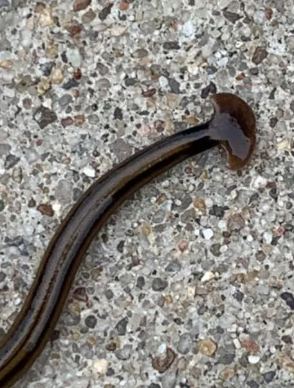 | Dark Brown |
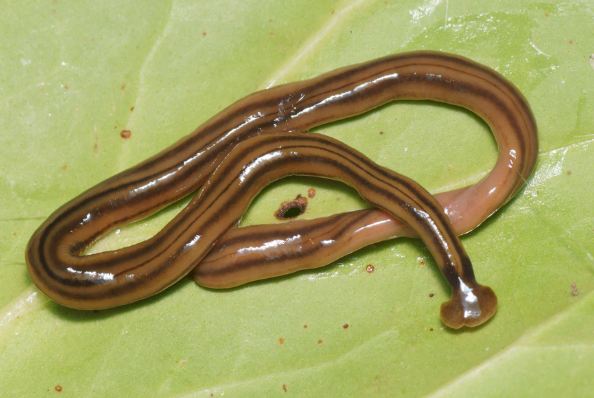 | Tan color with black stripes |
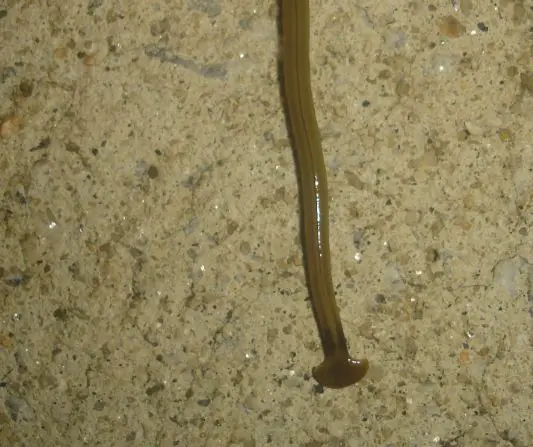 | Grey Colour Hammerhead Worm |
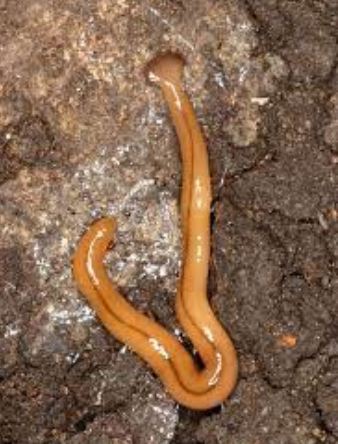 | Orange Worm |
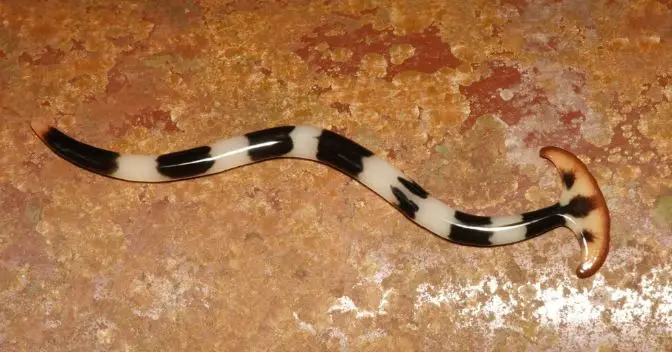 | Black and white hammerhead worm |
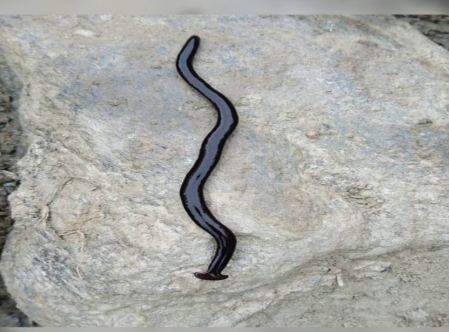 | Black Hammerhead worm |
History of Hammerhead Worms
American Scientist Stimpson was the first person to define hammerhead worms as broadhead land planarian”.After this, in 1899 Ludwig Von Graff divided it into 3 genres:
- Bipalium
- Pterocephalus
- Plagiocephaly
Joseph Muller in 1902 combined all the above-mentioned genres under the label of Bipalium. He argued that there was no significant evidence of distinction. Later on, Graff also accepted Mueller’s decision of reuniting all genres under Bipalium.
At the end of the 20th century, “The Land Planarian Index Series” was published. The author of this series Robert E Ogren and Masaharu Kawakatsu first kept them under the label of Bipalium. Later on, they divided it into 4 genres on the basis of reproduction.
- Bipalium
- Novibipalium
- Humbertium
- Diversibipalium
Historically, hammerhead worms are native to Southeast Asia and Madagascar. They are found everywhere in the world. Now they have reached the UK, USA, and Europe with other crops. However, they are found occasionally due to dependence on humidity.
Hammerhead Worm Eating
Is it safe to eat hammerhead worms? Eating hammerhead worms is totally unsafe. Its mucus contains a toxin which is highly potent tetrodotoxin. If taken in large amounts it can kill you. If your pet has eaten this worm, monitor him for symptoms. The poison in it can cause discomfort in breathing, vomiting, and stomach pain.
If you see this worm in your yard, catch it and put it in a bag. Now dispose of it far from the population. They don’t survive in extreme temperatures. When you see a high number of these, it’s time to seek professional pest control help.
Hammerhead Worm in Skin
If you are trying to handle a hammer worm in the skin just like a leech, you can fall into big trouble. They have toxins on their slimy skin. They use this toxin to paralyze predators. This toxin has the ability to disconnect the nervous system of worms from the body. As a result, worms leave mobility.
This toxin is not good for human as well as animal skin. If you see this worm on your pet, try to pick it up with gloves in your hand. Pack it and dispose of it far away. You can throw salt or vinegar to kill it.
Hammerhead Worm Pet
Can you keep hammerhead worms as a pet? No, not at all. They’re unsafe to keep as a pet. If you keep them in your yard, they will eat up all beneficial earthworms. Moreover holding them in their hands can cause infection and itching to the skin. It can also alleviate allergic symptoms. They are parasitic and cause diseases if kept near the human population.
Unlike earthworms., it’s unsafe to keep hammerhead worms as a pet. They are terrible for the environment, humans, and pets. Although they don’t directly bite yet they secrete toxins from the skin. So it’s better to kill them wherever you find them.
Hammerhead Worm Size
Hammerhead worm size varies considerably depending on the species. They can be as small as 1.3 inches and as long as 12-inches. Bipalium vagnum is the smallest species measuring 0.98-inches.
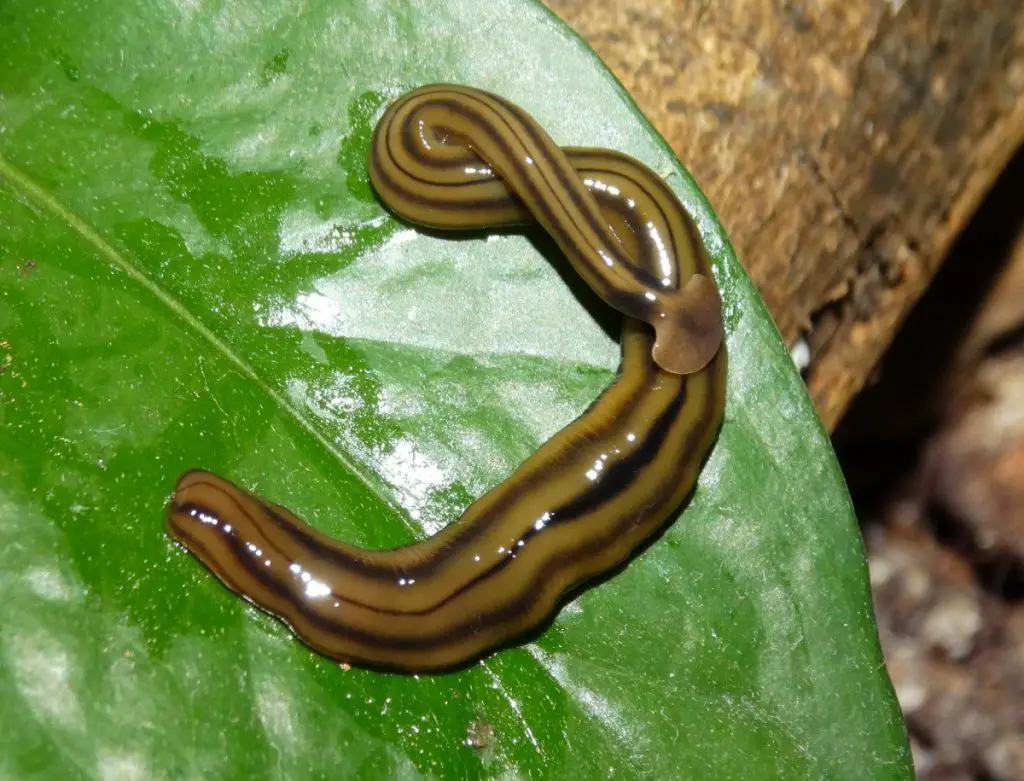
How big is a hammerhead worm? Usually, they can grow 7 to 12-inches. The smallest species are Bipalium vagum 25mm, while the longest species are Bipalium Kewense measuring 20cm in length. Below is a chart of the size of different species of hammerhead worms:
| Headworm Species | Size | Images |
| Bipalium Vagum | 0.98-inch to 5-inch | 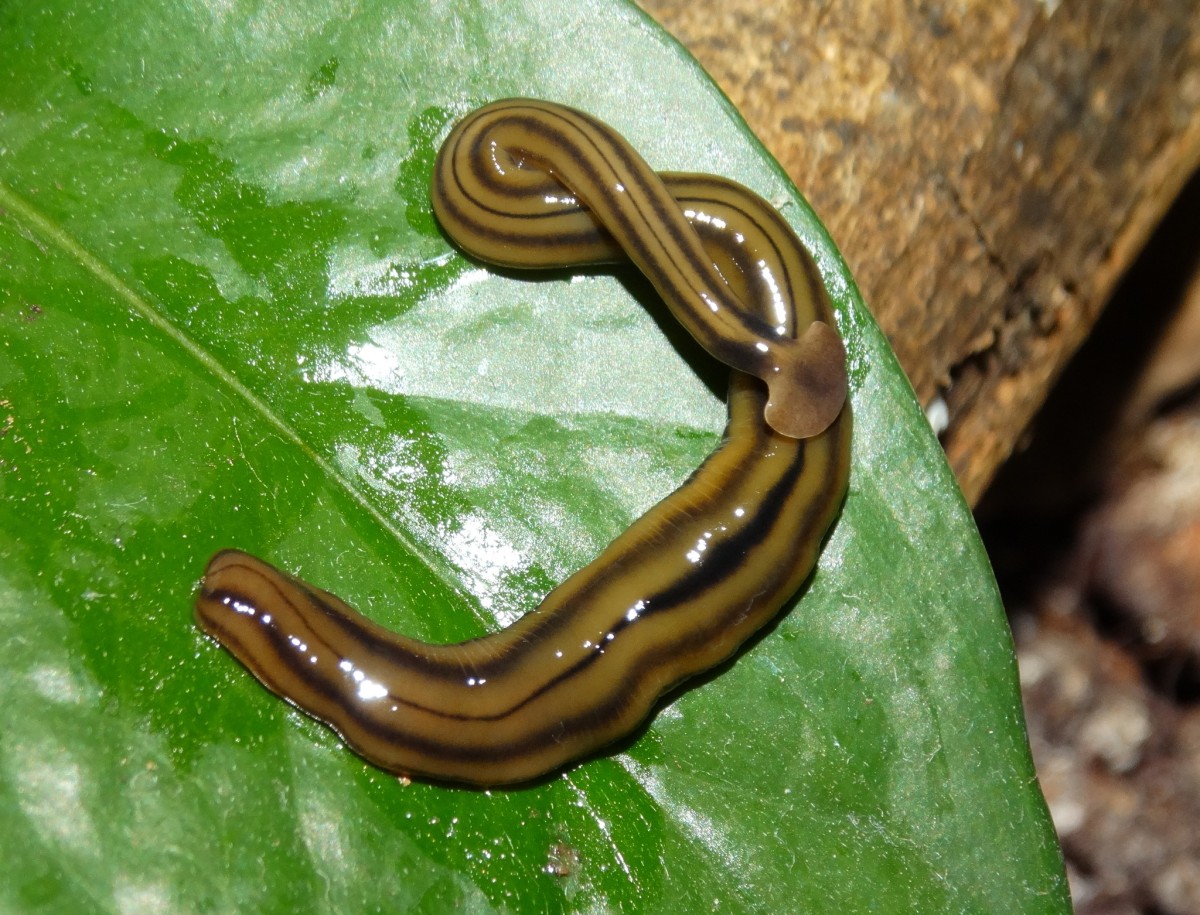 |
| Bipalium Pennsylvanicam | 3-inch (8cm) | 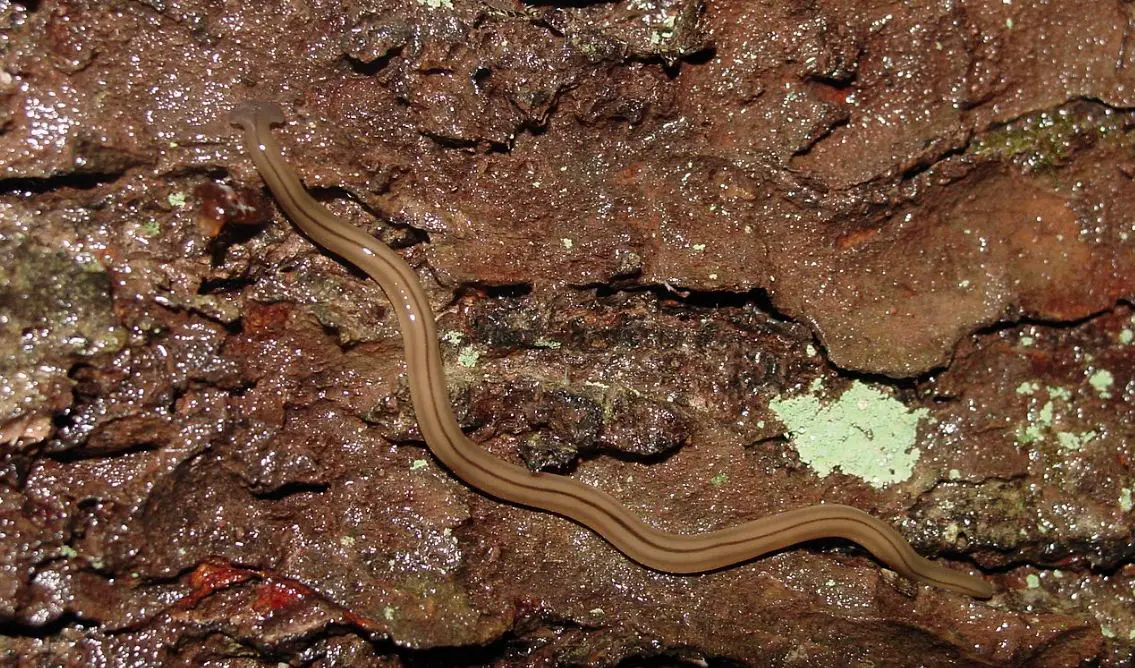 |
| Bipalium Adventitium | 5 to 8cm |  |
| Diversipal multilineatum | unknown | 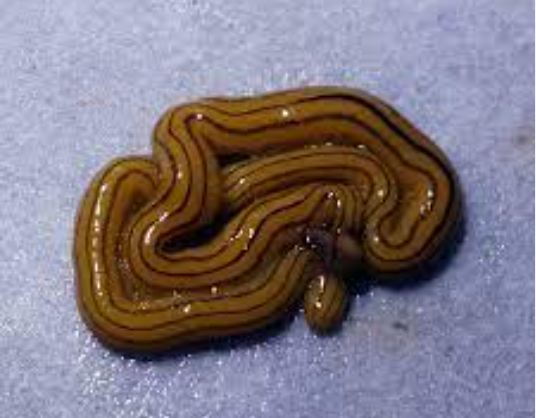 |
| Bipalium fuscatum | unknown | 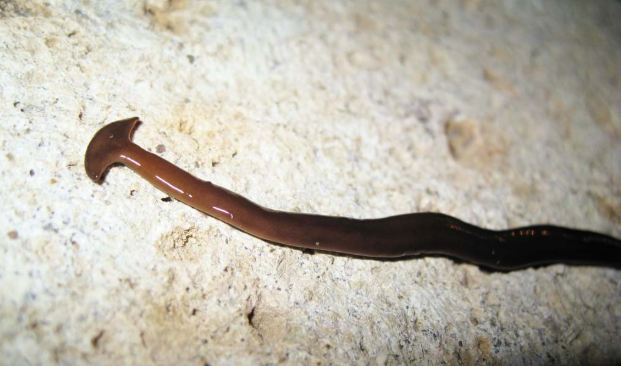 |
| Bipalium Strubeli | unknown | 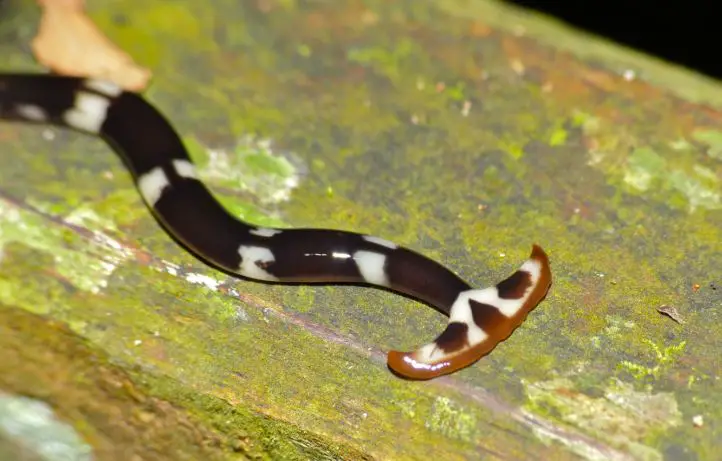 |
Hammerhead Worm Eggs
Do hammerhead worms lay eggs? Yes, they do lay eggs. The eggs are developed inside the body of females after fertilization. It is then released as a capsule. It takes three weeks for offspring to get mature and hatch the eggs. The offspring are as thin as hair when they emerge.
What do hammerhead worm eggs look like? They look like colorful cocoons, mostly red or black. Each cocoon is filled with eggs. If you want to control the population of this worm, its eggs should be removed. The best way is to pack them and throw them away from the population.
Hammerhead Worm VS Leech
Hammerhead worms and leeches are different in many aspects. Both are different worms in shape, size, class, phylum, color, and habitat. Let’s check out the main differences:
The first one belongs to Phylum Platyhelminthes, while the second is included in Phylum Annelida. The physical appearance of leeches is different from hammerhead worms. It is small in size and bears muscular segmentation. The worm has a snake-like non-segmented body.
Another difference is habitat. The hammerhead worm worms over the land in hot and tropical regions. Leeches live both in freshwater=ter and land. Land leeches need moisture or wood foliage to thrive well.
Next, hammerhead worms are harmless to humans until they touch them. They can’t bite or sting. However, leeches can bite and cause enough bleeding. The saliva of leeches can disturb blood clotting quality.
Lastly, hammerhead worms have no significant brain or nervous system. On the other hand, a leech has 32 brains and 10 eyes. However, its eyesight is quite poor.
Hammerhead Worm Cut in Half
What happens if the hammerhead worm is cut in half? Unfortunately cutting this wow doesn’t kill it. It will either regenerate from its cut segment into two. The tail portion will regrow its head and head protrusion will regrow its tail. Some even claim that if you cut it into 10 pieces. it will regrow into ten worms. It’s not an authentic or proven fact.
They have the ability to reproduce asexually. They are basically immortal and it’s really hard to get rid of them. Within a week, the chopped or cut segment will regenerate into the full organism. So experts advise” Don’t cut it up”.
Hammerhead Worm VS Earthworm
Although both worms are species of flatworm, they are totally different in color, shape, size, and reproduction.
Hammerhead worms have crescent-shaped heads and nonsegmented bodies, while earthworms have well-defined segmented bodies with tubular-shaped heads.
Hammerhead worms are snake-like creatures that can grow 5cm to 12cm. On the other hand, earthworms are small in sizes 7 to 8cm. Only a few species of earthworm can grow more than 35cm.
Hammerhead worms are invasive and toxic creatures. They release toxins to pray to earthworms and other animals. While earthworms do not pose any threat to humans and pets. They are even beneficial to plants.
Hammerhead worms have a variety of colors: bright yellow, dark brown, orange, gray, and tan. On the other hand, earthworms mostly have a reddish-brown color. The former has stripes running along the body while the latter has no stripe pattern.
Hammerhead Worms are mostly carnivores, while earthworms are omnivores. They eat both plants and animals. The hammerheads eat slugs, snails, other worms, and slimy insects.
Hammerhead Worm Wisconsin
Are hammerhead worms found in Wisconsin? No, there is no significant evidence of hammerhead worms in Wisconsin. The invasive species of flatworms found in Wisconsin are jumping worms also known as Asian worms, crazy worms, Alabama jumpers, and snake worms.
These jumping worms are native to eastern Asia. These worms are very hard to handle. However, hammerhead worms are found in neighboring areas of the US. Hammerhead worms have reached the neighboring states of Wisconsin, especially Missipie.
Hammerhead Worm Facts
Hammerhead flatworms are themselves interesting and unusual planarians. They are terrestrial animals with elongated bodies and crescent-shaped heads. They are generally harmless to humans unless they try to handle them. Below are a few fast facts and scientific facts about this worm:
| Hammerhead worms | Facts |
| Scientific Name | Bipalium sp |
| Kingdom | Animalia |
| Class | Rhabditophora |
| Order | Tricladida |
| Family | Geoplanidae |
| Phylum | Platyhelminthes |
| Habitat | High humidity and warm areas |
| Diet | Snail, slugs, earthworms, insects, and soft-bodied animals |
| Size | 15cm to 20cm |
| Color | Varied yellowish, orange, tan, brown and |
| Shape | Snake-like body with crescent-shaped head |
- This worm is sometimes confused with slugs. For this reason, it is also called hammerhead slugs. They are different from slugs as they dont have tentacles. Similarly, they’re different from earthworms as the body is not segmented.
- They belong to land planarians. They spread the pharynx out of the body to feed marine animals or other worms.
- Hammerhead worms don’t have an organized respiratory and circulatory system. Oxygen is absorbed by the skin cells and carbon dioxide is also released through the skin.
- The mouth of the hammerhead worm is located in unusual places. It hunts through the pharynx. It keeps the engulfed food inside the intestine where digestion takes place.
- They don’t have specific organs such as the brain. The cerebral ganglion in the head region acts like a brain. These ganglions are connected to nerve cells to transmit messages throughout the body.
- The sense organs of hammerhead worms are located on the surface of its body. It has the ability to differentiate light and dark areas. The eyes of this worm are located on its head. The head has chemoreceptors to sense the environment.
- They appear to glide or wriggle over the ground as they move. They have thin hair-like cilia underneath the body to help them to move.
- They have protonephridia that do the same functions as kidneys do in humans. These protonephridia contain hair-like cellular structures called flagella. This flagellum is similar to cilia. They move back and forth rapidly to push the fluid out of the body through excretory pores.
Hammerhead Worm Eating Snail
Do hammerhead worms eat snails? Yes, they are active hunters of snails. Marine flatworms often find them close to their habitat. First, it would wrap its body with its mouth. Next, it would immobilize it with the help of its toxic secretion. After this, it will devour it.
Snail is a soft-bodied animal, easy to catch and devoured by many flatworms. Almost all species of flatworms are active predators of snails. There are many videos on youtube where you can see hammerhead worms hunting snails.
Hammerhead Worm North Carolina
Are there hammerhead worms in North Carolina? Yes, they have been invading there since 1950. The species found in NC mostly have dark five stripes, yellowish color, and snake-like bodies. They have hammer-shaped heads and broken collars around the neck. Beware they are not good for your pet and garden.
This species came to NC with soil imported from tropical regions. IT is also transported with plants from other areas. Although they are seen occasionally, they’re harmful. What to do if you see a hammerhead worm in North Carolina? You should kill it because it is harmful. Killing does not mean crushing or chopping with a shovel. They can regrow from cut fragments. The right way to get rid of them is to put them in the freezer, with salty water and soapy water.
Hammerhead Worm Alabama
Are there hammerhead worms in Alabama? Yes, they are frequently seen in the gardens of Alabama. The summertime after rain is perfect for them to come out. Experts say that they are likely to spread all across the United States soon. They are the biggest concern for earthworms. The invasive species of this worm are spotted on the Gulf Coast of Alabama. The reason is that they are found in hot and humid areas.
What to do if you see hammerhead worms in Alabama? They are dangerous for you and your garden. They release toxins that can make you ill. Furthermore, they carry parasitic nematodes. They are not good for the fertility of soil as they kill beneficial earthworms. So, the only solution is to kill them by dissolving them in salty water and vinegar.
Hammerhead Worm Mouth
If you’re a creeper lover you might be surprised to locate a hammerhead worm’s mouth? Do they have mouths? Yes, they have, it’s located underside of the body and directed towards the middle. They use its mouth to wrap around the prey. They’re significant predators of earthworms, snails, and slugs.
The strange thing about this creature is that its mouth is also its anus. It secretes enzymes to immobilize its prey. After this, it can easily eat it up. If you want to see its mouth, the right time is to catch it as prey.
The feeding organ of this animal is the protrusible muscular pharynx. This organ opens in three-branched intestines.
Hammerhead Worm Pennsylvania
The most common flatworms found in Pennsylvania are hammerhead worms. They’re identified with its yellow color and stripe pattern, and arrow-shaped heads. Five species of hammerhead worms are found in Pennsylvania named adventitial, 5-stripe kewense, pennsylvanicuum, vagum, and multilineatum.
All of these species are also reported in Eastern North America. They can be identified by shape of Bipalium adventitium
head, a number of dark stripes, collar, and size. If you want to identify the species of bipalium found in pennsylvania, check the table below:

Image credit: Wikipedia.org
Hammerhead Worms Species Found in Pennsylvania
| Name Of Hammerhead Species | Size | Number Of Dark Stripes | Collar | Color |
| Bipalium adventitial | 3.1-inches | 1 dark brown stripe | Collar absent | Tan or yellow-brown |
| Bipalium Kewense | 12-inches | 5 dark gray or brown stripes | Partial collar present | Dark brown |
| Biplalium Pensylvanicum | 5.1-inches | 3 dark and light brown stripes | Collar absent | Tan or yellow-brown |
| Bipalium Vagum | 1-inches | 3 brown stripes | Complete Collar Present | Tan or Yellow brown |
| DiversiBipalium Multilineatum | 12-inches | 5 dark brown and black stripes | Collar Absent | yellow-brown |
Hammerhead Worm Virginia
According to the Charlotte Observer Report, news, a Virginia resident discovered a snake that was actually an invasive worm impossible to kill. The name of this worm was Hammerheadworm. Virginia Wildlife Management and Control (pest Control Company)posted on its Facebook page that the snake-like creature found in Midlothian was actually a hammerhead worm. They also posted its video on Instagram.
Pest control authorities suggested killing them by dissolving them in salt water or pouring orange essence. Before this, there was no such freaky creature observed in Virginia. However, in Texas and Louisiana, hammerhead worms are common.
Hammerhead Worms Invasive
Hammerhead worms are invasive species of Land planarian. They have almost turned up in every part of the world. However, they were not native to Europe and the United States. They reach there through shipment of horticulture. Now they are found everywhere in humid and hot areas of the UK, US, and Europe.
They are native to Asia and Madagascar. According to reports, hammerhead worm invasion is not good for the ecosystem. Experts say that they are harmful to humans as they carry parasites. With time, its invasion of tropical regions is increasing rapidly. It’s one of the biggest concerns for the population of earthworms. One thing that can restrict its number is extremely hot weather. The research related to hammerhead worm invasion is not well funded. Dry summers in New England can restrict its population due to its need for humidity to survive.
Hammerhead Worm in House
Is it common to find hammerhead worms in the house? If you are talking about inside the house it is less common. However, you can find them in yards and toilets. The larva can easily make its way to the bathtub and sewer to reach the toilet. No need to worry if you find them inside the house.
What to do if you find a hammerhead worm in the house? The first thing that can frighten you is its resemblance to a snake. Make sure it’s not a snake by identifying hammer shape outgrowth on its head. Stay calm, they will not sting or bite you or your pet. However, if you try to touch them, the toxic chemical on their skin can cause itching. It’s better to kill them if you find them in the house. They’re by no means safe for residents.
After killing them, don’t forget to dispose of them properly. Otherwise, they will again make their way there. Check your sewerage and drainage before a rain if you’re living in tropical areas. During high humidity, they come out of the soil and can be sited in the yard.
Hammerhead Worm Georgia
In Georgia, a nonnative invasive hammerhead worm species has been making headlines recently. They have been invading Georgia for years. Pesticides Control authority poses this worm havoc on the ecosystem. Its population has been increasing drastically since last summer. They are dangerous predators of earthworms, the most beneficial worms for the environment.
If you see a hammerhead worm in Georgie, Should you kill it? Yes, you should obviously kill it. However, don’t chop them with a shovel. The best way to get rid of them is to douse them in salt, vinegar, alcohol, and boric powder solution.
What is the color and shape of hammerhead worms found in Georgia?
The species of land planner found in Georgia are long, varied in colors, and snake-like 8 to 15-inches in length. Brown color defense is most common in Georgia as compared to other colors. If you want to locate them, search for them in areas with high humidity. You can also find them easily, somehow far or close to earthworms.
Hammerhead Worm Tennessee
Warning for Tennessee residents: Hammerhead worms have got there!
According to the news posted in WKRN from Nashville, Hammerhead worms have turned up in Tennessee and surrounding areas. However, the good news is that they are not in high numbers.
Talking about this worm, Dr.Karen posed the biggest threat to the environment. They are primary predators of earthworms which are effective for the fertility of the soil. Dr.Vail recommended hammer worms, the biggest threat to earthworm raisers.
If you see hammerhead worms in Tenens, report it to nearby pest control authorities. If you can do it, catch the worm and dispose of it in a plastic bag. It is better to kill them by dissolving them in salty or soapy water. Never ever try to crush them with a hoe, they will regenerate into two.
If you’re worried about hammerhead head worm infestation, read how to get rid of hammerhead worms thoroughly.
Hammerhead Worm in Toilet
It is rare to find hammerhead worms swimming in your toilet. It can make you surprised to know how it got there. No need to get scared, just pick it with a tweezer and put it in a plastic bag. Now dissolve it in vinegar or salty water solution. If you don’t want to kill it, dispose of it in areas far from human and animal populations.
When you see a hammerhead in a toilet, you actually see its larva. The larva is a thread-like tiny body that can make its way through sewage or any toilet pipe cracks. The moisture of the toilet and toilet pipes attract it to go on. In this way, it makes its way to the bathtub.
It can also get into the toilet with your shoe or clothes. When someone works in a garden or yard, creatures like worms can stick to your pants and shoes. When you enter the toilet with these clothes, the worm jumps to the moisty floor of the toilet.
Now the question is what to do with a hammerhead worm in the toilet? Don’t flush it, or crush it. Pick it with gloves in your hands, not with bare hands. Now pack it in a plastic bag. Finally, dispose of it far away from the population.
People Also Ask
How Many Hammerhead Worms Are in The World?
Unfortunately, there is no exact figure for the total number of hammerhead worms found in the world. They are present all around the world. Wherever there are earthworms, you can expect the presence of hammerhead worms. Due to insufficient funds for its research, the number has not yet been counted.
How Did Hammerhead Worms Get to Texas?
Hammerhead worms get to Texas with exotic plants. It was transferred to Texas through its eggs hidden in the soil. They have a high tendency to spread quickly because of the lack of predators. It has been in the USA since 1900. With time, it reached many other states as well.
Do Hammerhead Worms Live Underground?
They live underground in the soil. Like other flatworms, they need humidity to survive. They occasionally come out of the ground for predation after rain. They are nocturnal. If you want to locate them, search for them near earthworm habitats.
When Were Hammerhead Worms Discovered?
The exact date when the hammerhead worm came into this world is unknown. However, they came to the Us around 1900. They spread through plantations all around the US. They were first discovered in Southeast Asia and Madagascar.
Conclusion
His invasive creature is no doubt a threat to your backyard. Interestingly, this threat is indirect, not direct. They dont tunnel, root, or feed plants. They indirectly prey on earthworms to destroy the ecological balance.
If you want to keep this slithery worm away from your yard, inspect potted plants. Try to buy clean plants from nurseries or seeds. Once this worm establishes itself in any locality, it would be hard to get rid of it.

